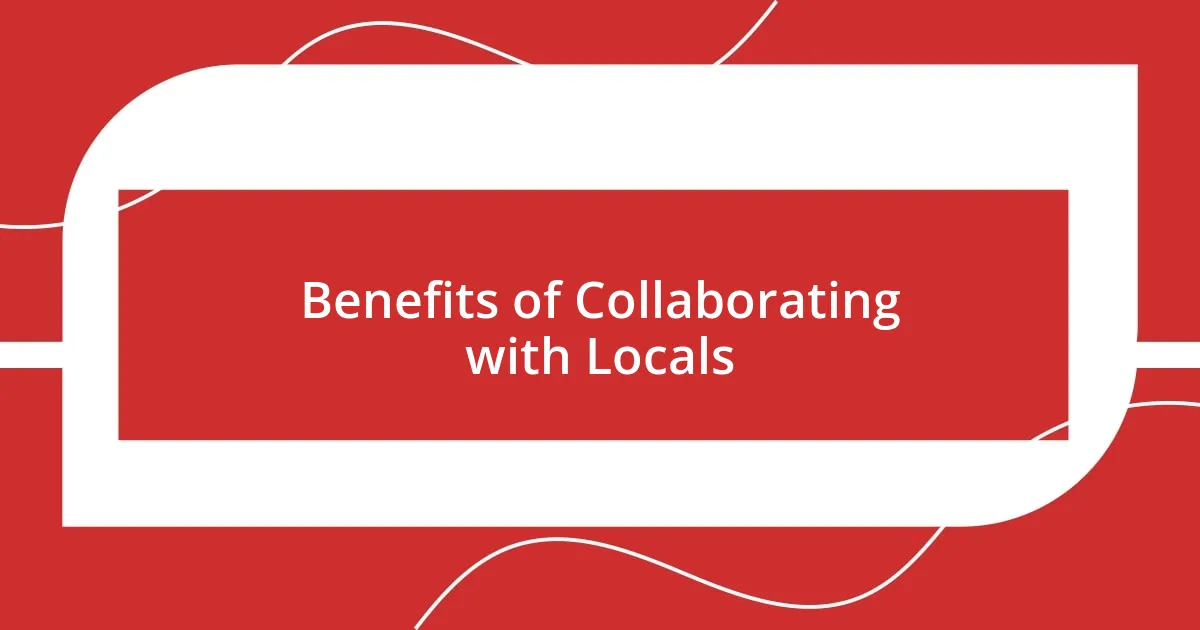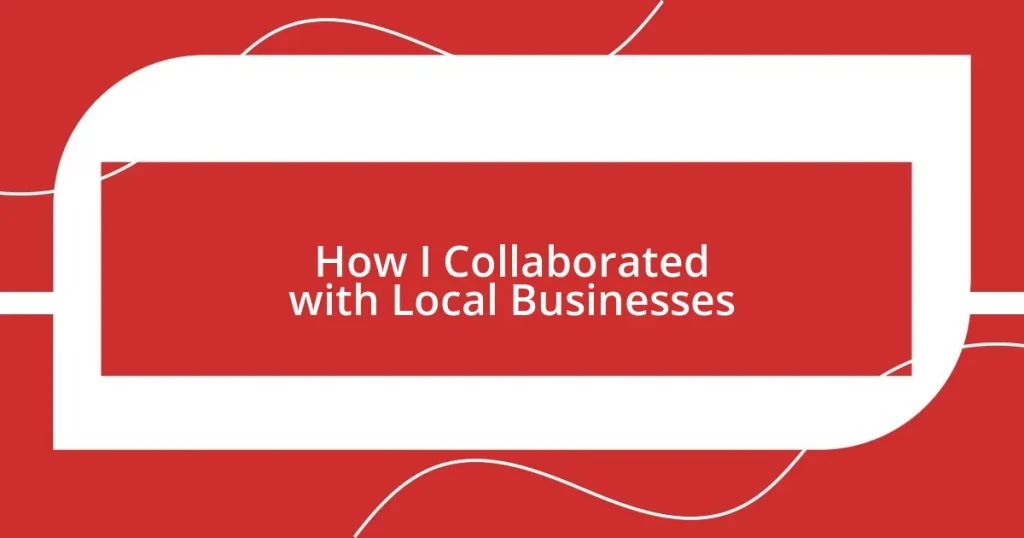Key takeaways:
- Successful local business collaboration relies on mutual benefit, trust, and open communication.
- Key benefits include shared resources, cross-promotion, community engagement, and fostering innovation.
- Identifying partners involves aligning values, networking, and utilizing social media for connections.
- Measuring impact extends beyond sales metrics to include community engagement and emotional resonance.

Understanding Local Business Collaboration
Local business collaboration is more than just a handshake or a shared project; it’s about building relationships that thrive on mutual benefit and trust. I remember the first time I partnered with a local coffee shop for an event—there was an undeniable thrill in combining our efforts to create something unique for the community. When businesses come together, they can leverage each other’s strengths, whether that’s sharing resources, connecting with wider audiences, or boosting local visibility.
As I think back on that experience, I realize that the best collaborations are rooted in understanding what each party brings to the table. Have you ever considered how collaborating with a local florist for your store’s opening could create a vibrant and inviting atmosphere? The emotional lift from those beautiful arrangements not only enhances the ambiance but also fosters an associative bond between your customers and those local services, deepening community ties in the process.
One of the core aspects of successful collaboration is open communication. I vividly recall a meeting where we brainstormed ideas with a neighboring boutique. The energy in that room was electric; every idea sparked new concepts and brought us closer. This back-and-forth not only fostered creativity but also cultivated a sense of shared purpose that excited us all. After all, when local businesses collaborate, aren’t we all winners?

Benefits of Collaborating with Locals
Collaborating with local businesses brings a wealth of benefits that can transform not just your business, but the entire community. I recall a time when I teamed up with a local gym for a wellness event. We both drew in our unique customers, creating a vibrant atmosphere that was both enriching and profitable. The cross-promotion not only enhanced our visibility but also fostered a stronger sense of belonging among our patrons, as they discovered new avenues for support right in their neighborhood.
Here are some key benefits I’ve seen firsthand:
- Shared Resources: Pooling resources can lead to reduced costs and increased efficiency, making projects less financially burdensome for all involved.
- Cross-Promotion: Every collaboration opens the door to a new audience; we effectively double our outreach by introducing each other’s customer bases to our respective offerings.
- Community Engagement: Local collaborations create events and campaigns that resonate on a personal level, reinforcing community bonds and encouraging locals to support each other.
- Trust Building: Partnering with other trusted businesses builds credibility. Customers feel more confident in what each business offers when they see others in the community backing them.
- Innovation: Working together sparks creativity. Different perspectives lead to fresh ideas that we might not have come up with on our own.
Every time I reflect on these collaborations, I’m reminded of the powerful atmosphere of community spirit they foster. It’s amazing how a simple idea can bloom into something much greater when local businesses join forces.

Identifying Potential Business Partners
Identifying potential business partners starts with a clear understanding of what you want to achieve. I remember when I was looking for a local bakery to collaborate with. I sought out not just any bakery, but one that shared a philosophy of quality and community engagement. It’s essential to pinpoint partners who align with your values, as that shared vision can create a more seamless partnership.
Next, networking plays a pivotal role in identifying prospects. I often attended local trade shows and community events to meet potential partners face-to-face. It’s fascinating how a simple conversation can reveal synergies that might not be evident on paper. Imagine standing beside a local artisanal cheese maker and suddenly realizing that your pop-up events could become more popular together. That unexpected connection can make all the difference.
Finally, I recommend utilizing social media to scout for suitable partners. I frequently browse community groups and pages where local businesses share insights about their services and events. This not only helps in gauging interest but also allows me to engage with potential partners directly. It’s surprising how often an online exchange can spark a collaboration idea that turns into a successful project. Have you tried reaching out through social media? It could open new doors for you.
| Approach | Description |
|---|---|
| Alignment of Values | Seek businesses with a shared mission to ensure smoother collaboration. |
| Networking Events | Attend local events to build relationships organically and explore synergies. |
| Social Media | Use platforms to discover and engage with local businesses, fostering potential partnerships. |

Strategies for Building Relationships
Fostering relationships with local businesses begins with genuine communication. I’ll never forget a coffee shop owner sharing stories about her struggles and successes during a casual chat. Those moments of honesty build trust and camaraderie. Have you considered how a simple conversation over coffee could open the door to collaboration? It’s in those shared stories that the seeds of partnership are often planted.
Another key strategy is to be present in the community. I regularly volunteer at local events, and I can’t express how valuable this has been for establishing connections. That hands-on experience allows me to meet business owners and locals alike, all while supporting causes I care about. If you’re out there, actively engaging, people will notice. Building relationships isn’t just about business—it’s about committing to the community.
Lastly, follow-up is crucial in relationship building. After meeting someone, I make it a point to send a heartfelt message or a simple “great to meet you” note. This small gesture reflects that I value our connection. Have you ever thought about how a simple follow-up could turn a fleeting encounter into a lasting partnership? I find that a personal touch often leads to deeper collaboration down the line.

Creating Win-Win Proposals
Creating a win-win proposal is all about understanding the needs of both parties involved. When I was crafting a proposal for a local artist to showcase her work at my coffee shop, I focused on what we could each gain from the partnership. I suggested hosting an art evening where her pieces would not only beautify my space but also attract potential customers for her. This alignment of interests made it clear: we were not just working together, but elevating each other’s brands in a way that felt mutually beneficial.
I’ve learned that incorporating specific details into your proposal can make a significant impact. For instance, when outlining a collaboration with a nearby bookstore, I proposed a combined event that featured readings and coffee tastings. By offering to promote the event through my channels and pooling resources, both businesses benefited from increased foot traffic and exposure. It’s interesting to think about how these little changes in strategy can turn a basic proposal into a vibrant opportunity for growth. Have you ever considered how a little creativity could reshape your own partnerships?
Ultimately, being transparent about expectations fosters trust and enhances collaboration. During my negotiations with a local gym, I was upfront about my desire for cross-promotion, while also offering them a discount on our coffee for their members. The openness led to a dialogue about what we both needed to succeed, ensuring we approached our partnership as allies rather than competitors. Think about it—how much easier is it to partner when both sides feel their needs are understood and valued?

Case Studies of Successful Collaborations
One of my most memorable collaborations was with a local bakery to create a special seasonal menu. We decided to craft unique coffee pairings that complemented her famous pastries. The excitement was palpable as we brainstormed flavors, and I still remember the joy on her face when we unveiled the pairing at a launch event. Engaging her customers in our café was incredibly rewarding; I felt like we were not just promoting our businesses but truly enhancing the community experience. Have you ever felt that buzz that comes when two creative minds come together?
In another case, I teamed up with a nearby fitness studio for a health and wellness week. We offered complimentary coffee to participants after their workouts. I was surprised by how many people showed interest in both our services, effectively bridging the gap between fitness enthusiasts and coffee lovers. Watching our engagement grow over those few days was an eye-opener for me. It truly highlighted how synergistic relationships can drive foot traffic and community interest. Have you ever thought about how easily you can connect different audiences for mutual benefit?
During a collaboration with a local florist, we held a floral arrangement workshop in my shop. We turned my space into a bright, vibrant retreat, filled with colors and aromas that drew in curious passersby. Seeing the delight on participants’ faces as they created their own arrangements brought me more joy than I expected. This partnership not only brought fresh life to my café but created a lasting memory for everyone involved. It makes me wonder: what unexpected joys could arise from a collaboration you initiate?

Measuring the Impact of Collaborations
Measuring the impact of collaborations goes beyond simple metrics; it’s about understanding the emotional and community resonance created. I remember analyzing the surge in our coffee shop’s sales after hosting an event with the local artist. The increase wasn’t just a number. It included the smiles on customers’ faces as they discovered her artwork and the conversations it sparked. Have you noticed how shared experiences can amplify engagement?
Another way I tracked the success was through feedback forms collected at collaborative events. After the health and wellness week, participants expressed how much they enjoyed experiencing both our services together. Some even shared that they now felt more inclined to explore healthier options, thanks to the connection we built. Isn’t it fascinating how feedback can reveal insights that numbers alone might miss?
Lastly, I turned to social media engagement, which often serves as a telling measure of collaboration success. The buzz generated from sharing photos and stories of these partnerships consistently led to increased online interaction for both businesses. I found myself fascinated by the comments and shares reflecting community joy and support. How do you currently gauge the impact of your partnerships? Sometimes, it’s the unexpected connections that tell the most valuable stories.















